Peter, 3rd Count de Salis
Peter de Salis, 3rd Count de Salis (Nobile Signor Don Pietro Podesta di Salis) (28 June 1738, parish of St. James, Westminster - 19 November 1807, Hillingdon, buried in the family vault at Harlington, Middlesex) was the second son of Jerome De Salis by his wife Mary, daughter of the first Viscount Fane. He was educated with his brothers, Charles and Henry, in the Grisons, in Chur where his tutor was Johann Heinrich Lambert, and then at Eton. He left Eton early in 1754 and was commissioned as an ensign in the 1st Regiment of Foot on 17 October 1754, which cost £900, subsequently he fought in the Seven Years' War, becoming a lieutenant on 27 October 1760. He left the army a captain and was sent by his father to the Grisons where he married a second cousin in 1763, she died, morte avec une fille en couches a year later. In 1765 he married a first cousin, she died 18 months later. In 1769 he married a combined third and fourth cousin, she bore him two sons and outlived him 22 years.
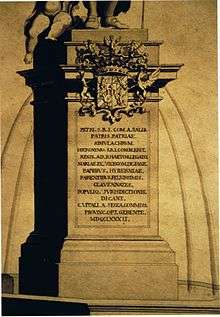
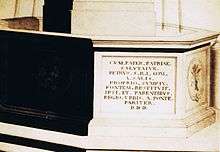
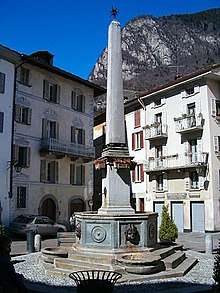
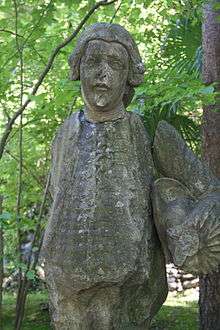
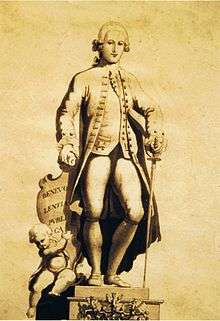

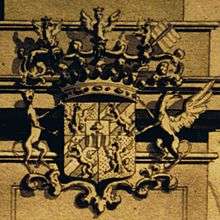
Character
His brother Charles in a letter to their mother, dated London, 16 April 1766, described something of Peter's mind:
- Peter writes to me his usual style, a perfect miniature of the lamentations of Jeremiah,
- The letter Par Lindau & par Coire, au païs des Grisons à Chiavenne'’, was '‘Recu in Leiden ce 22 ayr: 1766 a six heures et demi du matin’', and was ‘Received le 9e. May 1766’' in Chiavenna.
Landeshauptmann
Salis was Governor and Capitaine General of the Valtelline 1771-1773, and 1781–1783, where, it was said at the time, with great munificence, insight and skill he hastened to relieve the poverty of the population of Chiavenna. Accordingly, in 1782 a statue was put up to him in a main square there. However, the statue was dismembered in 1797. Fragments survive.
Anglo-Irish property

In March 1785 he inherited his mother's half share of the Bourchier-Fane estates in counties Limerick and Armagh, (Ireland). On 13 November 1785 he returned to England, landing with his family at Dover. From then he styled himself Esquire and lived mostly at 19 Orchard Street, near Portman Square; 11 Great Cumberland Street; in Hayes; and then at Hillingdon Park, Hillingdon-heath, near Uxbridge, a fine villa which Joseph Bonomi designed for him c. 1795-1797.
The Hon. Peter de Salis, Count of the Holy Roman Empire, died 19 November 1809 at his house on Hillingdon-Heath. (from The Times, 26 November 1809)
He was succeeded in his British estates by his elder son, Jerome and his younger son John/Johann/Giovanni seems to have inherited his Grisons property.
Some Ancestors
| Peter De Salis (1738–1809) | Father: Jerome, Count De Salis |
Paternal Grandfather: Peter, Count de Salis-Soglio |
Paternal Great-Grandfather: Antonio de Salis-Soglio |
| Paternal Great-grandmother: Perpetua v. Planta-Zuoz | |||
| Paternal Grandmother: Margherita v. Salis-Soglio (casa di Mezzo) |
Paternal Great-Grandfather: Hercules v. Salis-Soglio | ||
| Paternal Great-Grandmother: Maria Magdalena v. Salis-Seewis | |||
| Mother: Hon. Mary Fane |
Maternal Grandfather: Viscount Fane |
Maternal Great-Grandfather: Sir Henry Fane, KB | |
| Maternal Great-Grandmother: Elizabeth Southcott | |||
| Maternal Grandmother: Mary Stanhope |
Maternal Great-grandfather: Hon. Alexander Stanhope | ||
| Maternal Great-Grandmother: Catherine Burghill |
His eldest brother Charles
Charles de Salis, unsuccessful Parliamentary candidate for Reading, 1761.
He was born on 25 July 1736 in the Parish of St. James, Westminster and died without children at Hieres, Provence, July 1781, aged 45.
He was the eldest son of Anglo-Grison diplomat Jerome, Count de Salis-Soglio, who had been Naturalized a British Subject in 1731, by his wife Mary, eldest daughter of Charles Fane, 1st Viscount Fane.
After some schooling with his younger brothers (Peter, Rev Dr. Henry, and William) in his father's ancestral homeland (the Grisons Republic), he studied at Eton from 1747-1753,[1] where he was one of the 250 pupils there at the time. He traveled abroad from 1757 to 1760; the tour covered Lausanne (university), Northern Italy, Rome, Naples, Coire, Paris, Turin, and Holland.[2]
His maternal uncle, an Irish peer, Charles, 2nd Viscount Fane (an Opposition/Bedford Whig), was one of the two Members of Parliament (MPs) for Reading from 1754 to 1761.
In 1761, De Salis stood in his namesake and uncle's place as one of the two MPs for Reading, but having been admitted to a Freeman/Burgess of the Corporation of Reading on 4 March 1761 he was well beaten at the poll on 25 March 1761. De Salis only obtained 258 votes, whereas the elected candidates polled 396 (John Dodd) and 355 (Sir Francis Knollys).[3]
After this defeat De Salis retired to southern France but returned on his uncle's death in 1766. He wrote to his mother about his uncle Charles Fane (c1707-1766) on 16 April 1766: I am afraid ... all the personal and real estates [in county Armagh; county Limerick; Devon; and Lower Basildon in Berkshire] subject to the payment of Lord Fane’s debts do not amount to much more than the lists of debts we have got in.[4]

After returning to Provence having executed his uncle's will in 1766, he continued to live at Arles, Salon, Nîmes and Hieres (also spelled: Hyères), where he died and was buried at the Couvent (Convent) des Cordeliers (now the Église Saint-Louis d'Hyères) in 1781.
On 6 April 1764 Charles' contemporary, Edward Gibbon, wrote in his diary whilst in Lausanne: De Salis d'une indifférence qui vient plus d'un défaut de sensibilité que d'un excès de raison (this translates as: De Salis [has] an indifference that comes more from a lack of sensitivity due to excess [of grape].).[5]
He seems to have shared with his mother, maternal-grandmother (Mary Stanhope), and to a greater degree, his maternal-aunt a predilection for the vapours. De Salis and his mother both received treatment in Provence to cure their own low-spirits from the renowned vapour theorist, Monsieur Pierre Pomme (Arles, 1735 - Marseille 1812) who practiced in Arles from 1751-1766.[6][7]
References
- Eton College Register, 1753-1790, R. A. Austen-Leigh, 1921, page 157.
- Fane de Salis MSS
- History of Parliament, 1754-1790, 1964.
- The History of Parliament: the House of Commons 1754-1790, ed. L. Namier, J. Brooke., 1964.
- Quoted from The Life of Edward Gibbon, by Rev. H. H. Milman, Paris, 1840, page 125. It is possible that Gibbon is referring to Charles' brother Peter, though as according to Horace Walpole (Walpole to John Chute, Paris, August 30, 1769 re a Pomme treatment on (the 17th) Lord Dacre, who was 'prescribed wine') Pomme recommended wine as a cure for the vapours it is most likely that this was Charles.
- See Monsieur Pomme's Traité des affections vaporeuses des deux sexes, ou maladies nerveuses, vulgairement appelées maux de nerfs, Lyons, 1764, etc. Not a valid source but the German Wikipedia has a respectable article on Dr. Pierre Pomme.
- Jean Monteil, 'Un manuscrit inachevé de Grasset' : Pierre Pomme et les maladies nerveuses au XVIIIe siècle. 'Manuscrit signalé dans la Revue Histoire des sciences médicales', 11, 2, 1977, pp. 60-62.


%2C_wife_to_Battista_%C3%A0_Salis-Soglio_(1654-1724).jpg)
%2C_in_Huguenot_waistcoat.jpg)
- R. de Salis, Quadrennial di Fano Saliceorum, volume one, London, 2003
- Rachel Fane De Salis, De Salis Family : English Branch, Henley-on-Thames, 1934.
- manuscripts & muniments.
- The Times, notice of death, 26 November 1807, (page 3, column F).
| Regnal titles | ||
|---|---|---|
| Preceded by Jerome, 2nd Count de Salis |
Count de Salis-Soglio 1794–1807 |
Succeeded by Jerome, 4th Count de Salis |